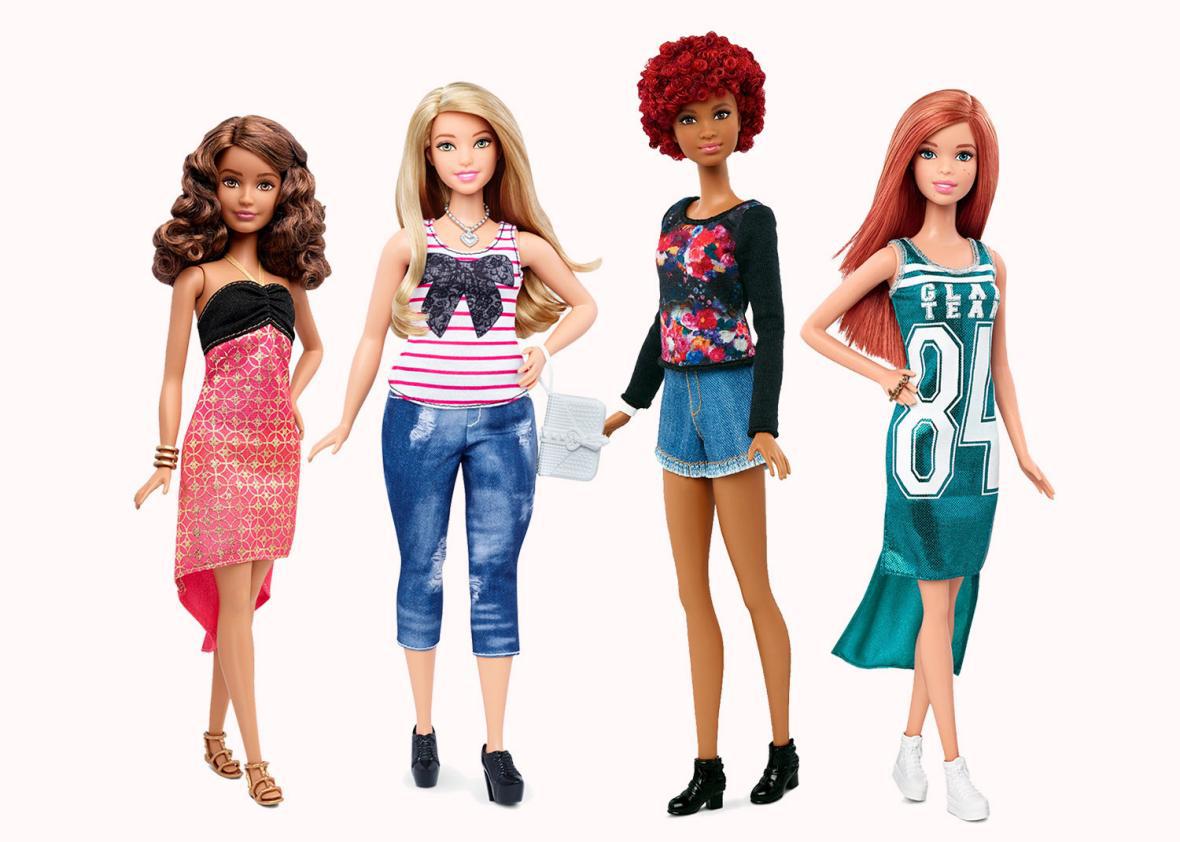After more than half a century of waiflike homogeneity, the hundreds of doll varieties collectively known as Barbie are welcoming three new body types to their cabal. Mattel has weathered accusations of promoting a harmful, unrealistic body ideal to young girls almost since the doll’s inception; finally, Eliana Dockterman reports in Time, after losing increasing market shares to other doll companies and seeing the Barbie brand lose clout among millennial mothers, Mattel has nudged the Barbie universe a few notches closer to reality.
In addition to the original Barbie shape, there are three new doll varieties, which are available online now and in stores later this year: “petite,” “tall,” and—the one concerned parents have been clamoring for most—“curvy.” The latter has wider hips, thighs that look like they could actually bike a few miles, arm-sized arms, and noticeable calves. She even has a little bit of an abdomen, though it’s hard to tell just how much without any unclothed photos. (And who could blame Mattel for keeping naked Barbie pictures off the Internet?) Petite Barbie looks just about the same as the original in Mattel’s images, though she’s ostensibly smaller all around. The tall Barbies are quite lanky and thin.
Certainly, the mechanics of doll creation present substantial obstacles for body diversity. It may be impossible, for instance, to avoid a thigh gap and maintain mobility for a pair of plastic legs. The limited quality of materials present in a $10 doll probably precludes any hope for cellulite or muffin tops. And for the first time, Barbie clothes will not be universally sized and interchangeable from one doll to the next—one of the primary reasons Mattel used to cite for keeping Barbie’s traditional shape, which allowed mothers to share their old Barbies’ clothes with their kids. All things considered, the new set of dolls is a refreshing step forward for a brand that millions of children still hold tight to their hearts.
Their mutual devotion to the doll poses an important opportunity for redirecting some of the body-shaming tendencies that take root at frighteningly young ages. For her Time cover story, Dockterman watched unattended little girls playing with the doll, presumably through some kind of two-way mirror. In one session, for the pleasure of her peers, a 6-year-old speaks as if she’s the curvy doll. Here’s what she says: “Hello, I’m a fat person, fat, fat, fat.” Later, when an adult arrives, she calls the doll “a little chubbier.” Another child says she doesn’t want to hurt that Barbie’s feelings, so she spells it: “F-A-T.” A Mattel research head told Dockterman that, when adults weren’t in the room, focus-group girls often undressed the curvy dolls and laughed at them.
These are kids who are barely out of kindergarten, and they already know that the thicker Barbie is the odd one out. Clearly, Barbie isn’t the only one indoctrinating young ones into the cult of superthin perfection. Celebrity culture, which promotes skinny bodies just as handily as Barbie, already has a vise-like grip on little girls’ psyches: Dockterman reports that most focus-group girls liked a blue-haired Barbie, whom they all associated with Katy Perry, best. This is one reason why last year’s Ava DuVernay Barbie—which gave the doll a career in a male-dominated field, hair twists, and a radically political celebrity namesake—was such a boon for the brand and a heartening reflection on the market that demanded it.
Barbie has seen several other promising changes in recent months. She may not need a knee replacement in her 30s now that she can wear flats, a feat insurmountable for her stiff, tippy-toed feet of yore. One of the tall Barbies comes with a double side-shave—a gender non-normative, though increasingly mainstream, trend. Mattel has introduced new-to-Barbie skin colors, hair styles, and facial features, too, to better reflect a world outside the exclusive blonde Dream House.
“Ultimately, haters are going to hate,” president and COO Richard Dickson told Dockterman of the Barbie criticism that is sure to continue in some form, even after today’s release. For now, the same is true of many kids raised with nothing but paper-thin bodies to admire. Curvy Barbie may be just a few millimeters heftier than her original mold, but in a doll this beloved, that’s a big start for little girls already afraid of f-a-t.
Read more from Slate on body image in women and girls (and dads):
